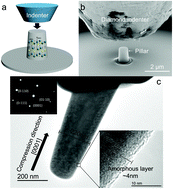Size-dependent fracture behavior of GaN pillars under room temperature compression†
Abstract
Gallium nitride (GaN) offers high electron mobility, breakdown voltage and saturation velocity, and is an ideal candidate for advanced electronic and power devices. Meanwhile, it can also be used for microelectromechanical systems (MEMS) and micro/nano-mechanical devices. These applications fundamentally rely on its mechanical properties and structural reliability, in particular at the micro/nanoscale. In this paper, single crystalline [0001]-oriented GaN pillars with diameters ranging from ∼200 nm to ∼1.5 μm were microfabricated and systematically characterized by in situ compression tests inside a SEM/TEM at room temperature. It showed that a crack would nucleate at the top of the pillars with diameters >800 nm and propagate axially during compression. However, pillars with diameters less than 700 nm would deform plastically without splitting, with maximum stress up to 10 GPa. The corresponding yield/fracture strengths show a strong size effect, which increases from ∼4 GPa to ∼11 GPa with the diameter decreasing from ∼1.5 μm to ∼400 nm. In situ TEM compression tests suggest that the formation of slip bands on the (0![[1 with combining macron]](https://www.rsc.org/images/entities/char_0031_0304.gif) 11) plane dominates the plastic deformation of the pillars with diameters of ∼200–700 nm, while both crack splitting and slip bands were observed in the pillars with diameters around 700 to 800 nm during the brittle-to-ductile transition. This work provides critical insights for developing robust GaN-based MEMS and power electronic applications.
11) plane dominates the plastic deformation of the pillars with diameters of ∼200–700 nm, while both crack splitting and slip bands were observed in the pillars with diameters around 700 to 800 nm during the brittle-to-ductile transition. This work provides critical insights for developing robust GaN-based MEMS and power electronic applications.



 Please wait while we load your content...
Please wait while we load your content...